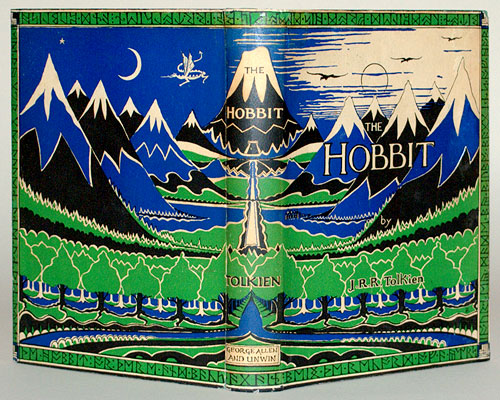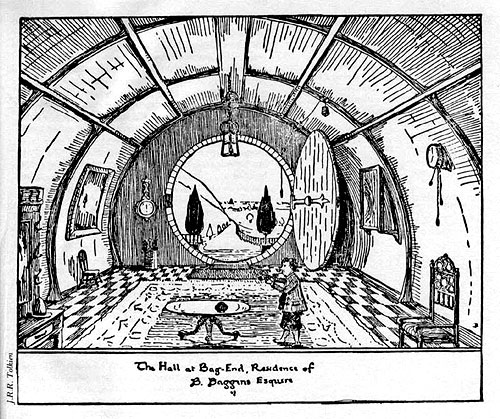"In a hole in the ground there lived a hobbit."
This is a class about The Hobbit. This is also a class about the man who created The Hobbit and the man (and his companions) who created a movie to tell the story of The Hobbit. This is mostly a class about the telling of that story, both in written form and in a set of three movies.
The Hobbit, or There and Back Again — the book — has been around for ages. Written by J. R. R. Tolkien and published in 1937, it has been published (and revised and added to) many times and has been translated into over 40 languages. It was written primarily as a book for children to read. The publishing firm of George Allen & Unwin hired Stanley Unwin's son, 10-year old Rayner, to review The Hobbit in 1936. His review stated,
"Bilbo Baggins was a Hobbit who lived in his Hobbit hole and never went for adventures, at last Gandalf the wizard and his Dwarves persuaded him to go. He had a very exiting [sic] time fighting goblins and wargs. At last they get to the lonely mountain; Smaug, the dragon who guards it is killed and after a terrific battle with the goblins he returned home — rich!
"This book, with the help of maps, does not need any illustrations it is good and should appeal to all children between the ages of 5 and 9."
The book turned out to be a favorite of many readers, not just those between the ages of 5 and 9. Tolkien was asked to continue the story, and he did so with The Lord of the Rings. It was published as a trilogy: The Fellowship of the Rings, The Two Towers, and The Return of the King. Changes were made to The Hobbit after the writing of The Lord of the Rings to accommodate the larger picture as presented in LotR, but they were kept in the same flavour of the story. One of these changes was to a scene that anyone who has read the books will recognize — in the first edition of The Hobbit, Gollum freely and willingly gives the Ring to Bilbo. After writing LotR, Tolkien realized that this had to change in the first book. Rewriting it, Gollum becomes a creature who is enslaved by the Ring — and also attempts to kill Bilbo rather than honor the agreement of the riddle game to show Bilbo the way out.
Tolkien later attempted a rewrite of the story, to be more in the format of his Lord of the Rings books, but stopped, realizing that it was, and is, a classic as it is. He felt it would lose a great deal of its simplicity and charm if retold for an older audience and incorporating the depth and detail of his larger vision of Middle Earth created for The Lord of the Rings (and other) books.
The Hobbit: An Unexpected Journey - the (first) movie - was released in 2012. The screenplay was written by a team of four people: Peter Jackson, Fran Walsh, Phillipa Boyens, and Guillermo del Toro (who had been originally chosen to direct the film before leaving the project in 2010).
The second film of the movie trilogy, The Hobbit: The Desolation of Smaug, came out in 2013. The last of the movies, The Hobbit: The Battle of the Five Armies, comes out in 2014. (Obviously the lesson about the third movie will be rewritten when the movie comes out.)
I chose to write this class because the sheer brilliance of the story, both in the original book and in the movie retelling, is astonishing. The original story points lightly at a mythos of perhaps an earlier time, with a clarity and simplicity of vision. Then, when making the movie, it is as if the team of screenplay writers rewrote the story, using information from the Appendices of The Lord of the Rings and other sources written by Tolkien, to give another view, a deeper view, of Middle Earth and its people.
The Hobbit, Or There And Back Again — J. R. R. Tolkien
"In a hole in the ground there lived a hobbit. Not a nasty, dirty, wet hole, filled with the ends of worms and an oozy smell, nor yet a dry, bare, sandy hole with nothing in it to sit down on or to eat: it was a hobbit-hole, and that means comfort."
 Those sentences start one of the most beloved stories of the 20th century. In the early 1930s, Professor J. R. R. Tolkien was marking papers (he was a professor of Anglo-Saxon at Oxford — the holder of the Rawlinson and Bosworth Professor of Anglo-Saxon Chair from 1925-1945) and came across an empty page. It is said, inspired, he wrote on it "In a hole in the ground there lived a hobbit." The sentence starts an epic adventure story — as told for, and to, children. He went on to write The Hobbit, or There and Back Again, and it was published September 21, 1937.
Those sentences start one of the most beloved stories of the 20th century. In the early 1930s, Professor J. R. R. Tolkien was marking papers (he was a professor of Anglo-Saxon at Oxford — the holder of the Rawlinson and Bosworth Professor of Anglo-Saxon Chair from 1925-1945) and came across an empty page. It is said, inspired, he wrote on it "In a hole in the ground there lived a hobbit." The sentence starts an epic adventure story — as told for, and to, children. He went on to write The Hobbit, or There and Back Again, and it was published September 21, 1937.
The story of The Hobbit
Bilbo Baggins, a rich and influential hobbit, lived in the Shire. Hobbits frown upon adventures as a general rule, but Bilbo Baggins had some Took blood, and they went on adventures. Nonetheless, his life was extremely tidy and reserved — one could almost say fastidious — until a visit from Gandalf the Wizard changed his life... and the course of history of Middle Earth.
Gandalf told a small company of dwarves to visit Mr. Baggins; they needed a burglar, and Gandalf said that was what Mr. Baggins was. The thirteen dwarves arrived, much to Bilbo's mystification, but he did his best to be the good, considerate host to a bunch of people he'd never seen before in his life. Gandalf arrived and explained the matter to Bilbo... in a way. The Dwarves needed a burglar and Gandalf remembered Bilbo as an adventurous lad. They also wanted another member for their group, because they numbered 13 and thought that to be an unlucky number.
The dwarves had been driven out of their homeland by a dragon; they intended to go back to their home and take back their gold. Auspices had been seen, and it was determined that now was the time to do it, if ever. One thing led to another, and yes, indeed, Bilbo did join the band — "To seek the pale enchanted gold".
 He did not decide to join them right away, however. The Dwarves left Bilbo's dwelling the next morning, with Bilbo having decided that he would not join them. In the morning, though, his Took side took over and he left his home, running after the Dwarves. Their journey started out pleasantly enough, but soon the adventures began. First they encountered Trolls and managed (with Gandalf's help) to turn them to stone. Then they encountered the Elves in Rivendell and rested for a while. The map that the Dwarves had was illegible to them but Elrond, the lord of Rivendell, could read it — so it was a very good thing that they stopped there.
He did not decide to join them right away, however. The Dwarves left Bilbo's dwelling the next morning, with Bilbo having decided that he would not join them. In the morning, though, his Took side took over and he left his home, running after the Dwarves. Their journey started out pleasantly enough, but soon the adventures began. First they encountered Trolls and managed (with Gandalf's help) to turn them to stone. Then they encountered the Elves in Rivendell and rested for a while. The map that the Dwarves had was illegible to them but Elrond, the lord of Rivendell, could read it — so it was a very good thing that they stopped there.
Unfortunately, after leaving Rivendell, the group of Dwarves (and Bilbo) encountered goblins, and Bilbo had a fateful meeting with a creature called Gollum. Then they met Beorn, a skin-changer who hated goblins more than he hated dwarves. Beorn helped them, first by giving them a place to stay for a couple of days, and then loaning them ponies, laden with several weeks' worth of food, for the journey. After leaving Beorn's place they encounter giant spiders... and then elves of an entire different ilk (the elves of the Woodland Realm) from the elves of Rivendell. The Dwarves were imprisoned for supposed trespass (and possible intent of theft). Our Hobbit, Bilbo, was not caught with the Dwarves. He proved his worth as a burglar by stealing the keys to their cells from an elven guard and devising a way out of their prison.
He did this with the help of a Ring that made him invisible. He found this ring in the mountains when the dwarves encountered, and escaped from, the goblins. The Dwarves ended up stuffed in barrels, riding along down the river to Laketown. There, through their stubborn determination (and the sheer presence of Thorin, the leader of the Dwarves), the Laketown people gave them provisions, and the gang of Dwarves plus Hobbit headed toward the mountain where Smaug lives — in the former home of the dwarves. Bilbo sneaked down into the mountain through the secret tunnels and encountered the dragon Smaug. After their little chat, Smaug started worrying about the Laketowners and went off to teach them a lesson. Bard the Bowman taught Smaug a lesson, though, and shot and killed him.
In the meantime, the Dwarves had waited long enough for Bilbo to return (they were trapped inside the mountain in a tunnel because Smaug collapsed the entrance). They traveled down into their former home and found all the treasures that Smaug had piled up. Thorin looked for one in particular — the Arkenstone. Bilbo found the Arkenstone and, although he knew that Thorin wanted it, he also knew that the Laketowners (and others who knew that the dragon was dead) had come to the mountain to claim their share of the treasure. Thorin was not willing to give them what they claimed and called for reinforcements from dwarf clans. War was pending and Bilbo, who was tired of all the posturing, stole into the camp of the Laketowners with the Arkenstone. He knew that Thorin would do anything to get it, and he also knew his name would be mud to Thorin forevermore when he does this. But Bilbo didn't want war and did what he felt necessary to circumvent it. When he entered the camp of men, he found Gandalf there, showed everyone the Arkenstone, and proposed his 'trade', knowing that Thorin would, indeed, have to accept it.
Then an enormous army of goblins, bats, wolves and wargs arrived, and the armies of human, dwarf and elf united to fight this new threat. The eagles arriving turned the tide, and the goblins and their host were defeated. Thorin, however, was severely wounded and knew he would die soon. He summoned Bilbo (who had been knocked out in the battle and so missed quite a bit) and forgave him. Bilbo was sad and wanted his adventure to be over. He left after healing some, stopped at Rivendell, and then went home to the Shire.
